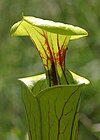Sarracenia flava
| Sarracenia flava subsp. var. | Yellow trumpet, Yellow pitcher plant | |||||||||||||||||||||||||||||||||||||||||||||||||||||||
|---|---|---|---|---|---|---|---|---|---|---|---|---|---|---|---|---|---|---|---|---|---|---|---|---|---|---|---|---|---|---|---|---|---|---|---|---|---|---|---|---|---|---|---|---|---|---|---|---|---|---|---|---|---|---|---|---|

|
|
| ||||||||||||||||||||||||||||||||||||||||||||||||||||||
| ||||||||||||||||||||||||||||||||||||||||||||||||||||||||
Sarracenia flava, the Yellow pitcher plant, is a carnivorous plant in the family Sarraceniaceae. Like all the Sarraceniaceae, it is native to the New World. Its range extends from southern Alabama, through Florida and Georgia, to the coastal plains of southern Virginia and South Carolina.
Like other members of the genus Sarracenia, the yellow pitcher plant traps insects using a rolled leaf, which in this species is a vibrant yellow in colour, and up to over a metre in height[1] (although 50 cm is more typical). The uppermost part of the leaf is flared into a lid (the operculum), which prevents excess rain from entering the pitcher and diluting the digestive secretions within. The upper regions of the pitcher are covered in short, stiff, downwards-pointing hairs, which serve to guide insects alighting on the upper portions of the leaf towards the opening of the pitcher tube. The upper regions are also brightly patterned with flower-like anthocyanin markings, particularly in the varieties S. flava var. rugelii and S. flava var. ornata: these markings also serve to attract insect prey. The opening of the pitcher tube is retroflexed into a 'nectar roll' or peristome, whose surface is studded with nectar-secreting glands. The nectar contains not only sugars, but also the alkaloid coniine (a toxin also found in hemlock), which probably intoxicates the prey. Prey entering the tube find that their footing is made extremely uncertain by the smooth, waxy secretions found on the surfaces of the upper portion of the tube. Insects losing their footing on this surface plummet to the bottom of the tube, where a combination of digestive fluid, wetting agents and inward-pointing hairs prevent their escape. Some large insects (such as wasps) have been reported to escape from the pitchers on occasion, by chewing their way out through the wall of the tube.
In spring, the plant produces large flowers with 5-fold symmetry. The yellow petals are long and strap-like, and dangle over the umbrella-like style of the flower, which is held upside down at the end of a 50 cm long scape. The stigma of the flower are found at the tips of the 'spokes' of this umbrella. Pollinating insects generally enter the flower from above, forcing their way into the cavity between the petals and umbrella, and depositing any pollen they are carrying on the stigmata as they enter. The pollinators generally exit the flower, having been dusted with the plant's own pollen, by lifting a petal. This one-way system helps to ensure cross pollination.
In late summer and autumn, the plant stops producing carnivorous leaves, and instead produces flat, non-carnivorous phyllodia. This is probably an adaptation to low light levels and insect scarcity during the winter months, and shows clearly the cost of carnivory.
The yellow pitcher plant is easy to cultivate, and is one of the most popular carnivorous plants in horticulture. The yellow pitcher plant readily hybridises with other members of the genus Sarracenia: the hybrids S. x catesbaei (S. flava × S. purpurea) and S. moorei (S. flava × S. leucophylla) are found in the wild, and are also popular amongst collectors.
| Standard Cyclopedia of Horticulture |
|---|
|
Sarracenia flava, Linn. Pitchers erect, 10-34 in. long, trumpet-shaped, with prominent longitudinal veins, yellow-green to green, often crimson throat, or deep crimson throughout; lid ovate-orbicular, slightly inflexed over mouth, with strong median nerve ending in mucro; wing narrow, uniform in width: fls. 2-3 1/2 in. wide, flavous yellow, odor rather pungent. Abundant over swamps and savannas, often in humus-sand that becomes dry in summer but moist in winter; S. Va. to W. Fla. Var. atrosanguinea, Bull (Mast.?). Pitcher and lid dark crimson-claret. Not uncommon from N. to S. C. over the coastal plain region. Var. limbata, Bull Lvs. medium to large, margin of operculum crimson. A rare form. Var. maxima, Mast. Lvs. large, uniformly yellowish green. Frequent in S. N. C. Var. minima, Mast. Lvs. small, 9-12 in., pale green with purple veins over tube and lid. Occasional with the type form. Var. ornata, Bull (S. Fildesii, Hort.). Lvs. 26-32 in., throat of pitcher and base of lid furnished with purple radiate lines. Frequent in N. and S. C. Var. Rugelii, Shuttl. (S. erythropus, Bull). Lvs. large, 26-34 in., top of pitcher and base of lid dark crimson. Frequent throughout Ga. and W. Fla. CH
|
Cultivation
Propagation
Pests and diseases
Varieties
Gallery
References
- ↑ Graham, D.L. 1997. Template:PDFlink Carnivorous Plant Newsletter 26(4): 118–120.
- Standard Cyclopedia of Horticulture, by L. H. Bailey, MacMillan Co., 1963
External links
- w:Sarracenia flava. Some of the material on this page may be from Wikipedia, under the Creative Commons license.
- Sarracenia flava QR Code (Size 50, 100, 200, 500)



